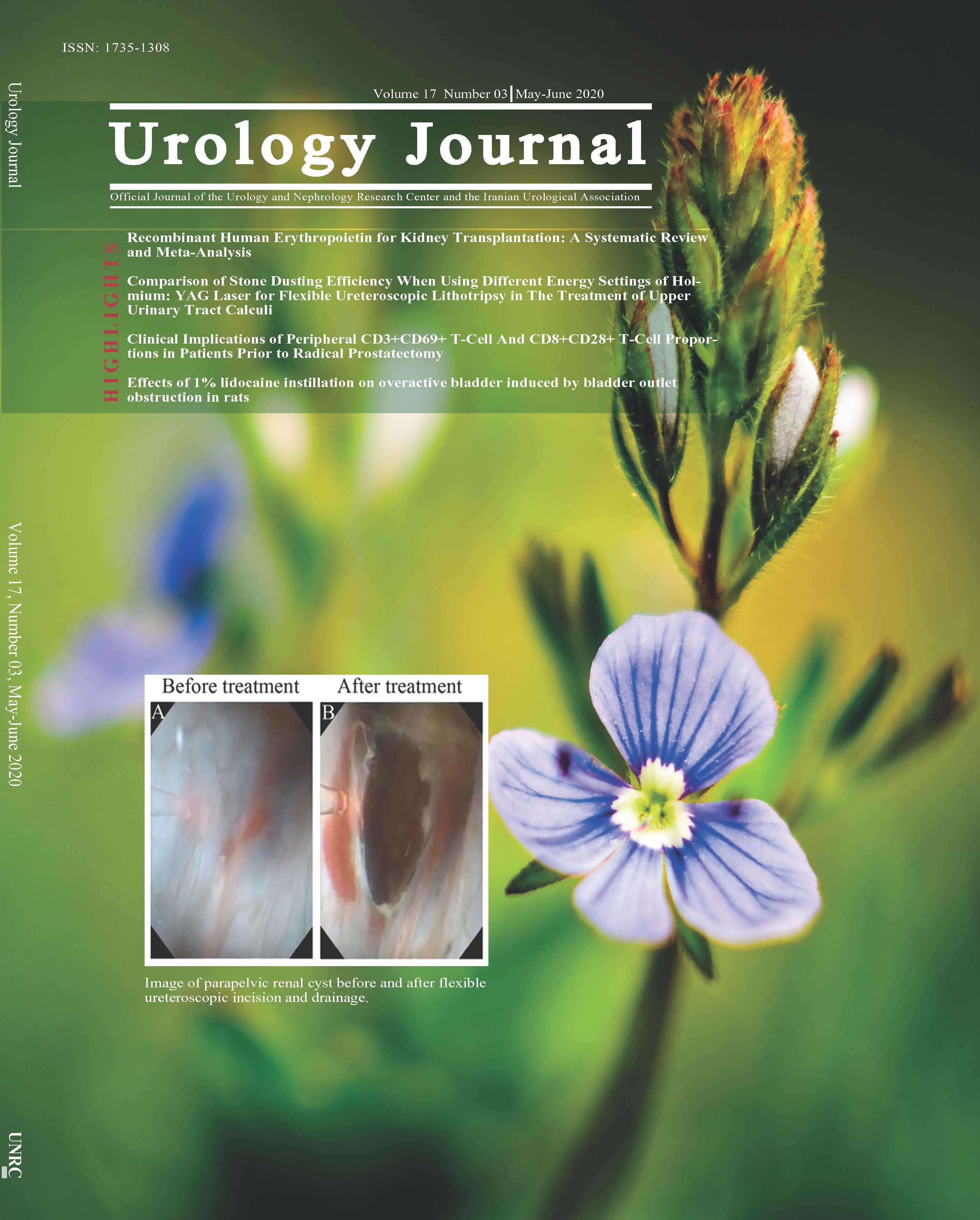Comparison of Two Different Scoring Systems in Encrusted Ureteral Stent Management: A Single-Center Experience
Urology Journal,
Vol. 17 No. 3 (2020),
16 May 2020
,
Page 248-251
https://doi.org/10.22037/uj.v17i3.5516
Abstract
Purpose: To report our single-center experience in encrusted ureteral stent management and to compare the utility of two different scoring systems, KUB (Kidney, Ureter, Bladder) versus FECal (forgotten, encrusted, calcified), in patient management.
Materials and Methods: We retrospectively analyzed the medical records of all patients who were found to have encrusted/retained ureteral stent and underwent various procedures to remove encrusted ureteral stent in our clinic between May 2014 and December 2018. Encrusted stent grading was performed using KUB and FECal grading systems. KUB system score is the sum of the stone burden scores of 3 different parts of an encrusted stent within the kidney, ureter and bladder determined using a scale from 1 to 5 according to the maximal diameter of encrustation. FECal grading system is based on the stone size, location and degree of stent encrustation and scored from Grade 1 to Grade 5.
Results: A total of 39 patients (29 males and 10 females) were included the study. The mean age of the patients was 46.4 ± 14.5 years, ranging from 13 to 71 years. The mean time from ureteral stent insertion to encrustation was 13.7 ± 26.4 months, varying between 2 and 120 months. The mean KUB score was 6.4 ± 2.4. According to FECal system, 53.8% of the patients were classified as Grade 1 and 15.4% as Grade 2. The encrusted ureteral stents of eight patients (20.5%) could be removed with the aid of a foreign body forceps inserted through a cystoscope. Fourteen patients (35.9%) underwent cystolithotripsy, seven (17.9%) underwent flexible ureterorenoscopy (URS), six (15.4%) underwent rigid URS, and three (7.7%) underwent combined percutaneous nephrolithotomy and URS beside stent removal. In multivariate regression analysis, largest encrustation diameter, FECal system grade and KUB score were found to be significant predictors of stone- and stent-free status (p<0.001 for all). Also, KUB score was found to be associated with the number of required procedures (r= .506, p= .001).
Conclusion: KUB encrusted stent scoring system might be useful in predicting the number of required procedures to achieve stone- and stent-free status. Pure intracorporeal endourologic procedures, percutaneous interventions or open surgery might be preferred according to the patient’s situation and the surgeon’s experience and preference.
- Ureteral stent
- forgotten
- encrusted
- calcified
How to Cite
References
Zimskind PD, Fetter TR, Wilkerson JL. Clinical use of long-term indwelling silicone rubber ureteral splints inserted cystoscopically. J Urol. 1967;97:840-4
Adanur S, Ozkaya F. Challenges in treatment and diagnosis of forgotten/encrusted double-J ureteral stents: the largest single-center experience. Ren Fail. 2016;38:920-6.
Niranjan A, Agarwal N, Agarwal V, Srivastava A. Enigma of forgotten double J stent. Saudi J Kidney Dis Transpl. 2010;21:157-9.
Hao P, Li W, Song C, Yan J, Song B, Li L. Clinical evaluation of double-pigtail stent in patients with upper urinary tract diseases: report of 2685 cases. J Endourol. 2008;22:65-70.
Bultitude MF, Tiptaft RC, Glass JM, Dasgupta P. Management of encrusted ureteral stents impacted in upper tract. Urology. 2003;62:622-6
Barreiro DM, Losada JB, Montiel FC, Lafos N. Urinary Incontinence and Urosepsis due to Forgotten Ureteral Stent. Urol Case Rep. 2016;8:63-5.
Acosta-Miranda AM, Milner J, Turk TMT. The FECal Double-J: A Simplified Approach in the Management of Encrusted and Retained Ureteral Stents. J Endourol. 2009;23:409-15.
Thomas A, Cloutier J, Villa L, Letendre J, Ploumidis A, Traxer O. Prospective analysis of a complete retrograde ureteroscopic technique with holmium laser stent cutting for management of encrusted ureteral stents. J Endourol. 2017.
Polat H, Yucel MO, Utangac MM, et al. Management of Forgotten Ureteral Stents: Relationship Between Indwelling Time and Required Treatment Approaches. Balkan Med J. 2017;34:301-7.
Bostanci Y, Ozden E, Atac F, Yakupoglu YK, Yilmaz AF, Sarikaya S. Single session removal of forgotten encrusted ureteral stents: combined endourological approach. Urol Res. 2012;40:523-9.
Arenas JL, Shen JK, Keheila M, et al. Kidney, Ureter, and Bladder (KUB): A Novel Grading System for Encrusted Ureteral Stents. Urology. 2016;97:51-5.
el-Faqih SR, Shamsuddin AB, Chakrabarti A, et al. Polyurethane internal ureteral stents in treatment of stone patients: morbidity related to indwelling times. J Urol. 1991;146:1487-91.
Veltman Y, Shields JM, Ciancio G, Bird VG. Percutaneous nephrolithotomy and cystolithalapaxy for a "forgotten" stent in a transplant kidney: case report and literature review. Clin Transplant. 2010;24:112-7.
Lynch MF, Ghani KR, Frost I, Anson KM. Preventing the forgotten ureteral stent: implementation of a web-based stent registry with automatic recall application. Urology. 2007;70:423-6.
Ziemba JB, Ludwig WW, Ruiz L, Carvalhal E, Matlaga BR. Preventing the Forgotten Ureteral Stent by Using a Mobile Point-of-Care Application. J Endourol. 2017;31:719-24.
- Abstract Viewed: 395 times
- pdf/5516 Downloaded: 279 times
